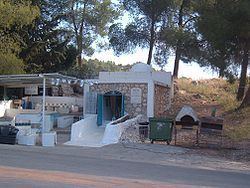 | ||
Honi ha m agel
Honi ha-M'agel (חוני המעגל Khoni, Choni, or Ḥoni, HaMa'agel; lit. Honi the Circle-drawer) was a Jewish scholar of the 1st-century BC, prior to the age of the tannaim, the scholars from whose teachings the Mishnah was derived.
Contents
During the 1st century BC, a variety of religious movements and splinter groups developed amongst the Jews in Judea. A number of individuals claimed to be miracle workers in the tradition of Elijah and Elisha, the ancient Jewish prophets. The Talmud provides some examples of such Jewish miracle workers, one of whom is Honi ha-Ma'agel, who was famous for his ability to successfully pray for rain.
Circle drawing incident
It is reported that, on one occasion, when God did not send rain well into the winter (in the geographic regions of Israel, it rains mainly in the winter), Honi drew a circle in the dust, stood inside it, and informed God that he would not move until it rained. When it began to drizzle, Honi told God that he was not satisfied and expected more rain; it then began to pour. He explained that he wanted a calm rain, at which point the rain calmed to a normal rain.
He was almost put into cherem (excommunication) for the above incident in which he showed "dishonor" to God. However, Shimon ben Shetach, the brother of Queen Shlomtzion, excused him, saying that he was Honi and had a special relationship with God.
Death
According to Josephus, in Antiquities of the Jews, Honi met his end in the context of conflict between the Hasmonean brothers Hyrcanus II, backed by the Pharisees and advised by Antipater the Idumaean, and Aristobulus II, backed by the Sadducees. Around 63 BC, Honi was captured by the followers of Hyrcanus besieging Jerusalem and was asked to pray for the demise of their opponents. Honi, however, prayed: "Lord of the universe, as the besieged and the besiegers both belong to Your people, I beseech You not to answer the evil prayers of either." After this, the followers of Hyrcanus stoned him to death.
Rabbinic tradition (Babylonian Talmud, Taanit) records a different story of his death:
Rabbi Yohanan said: "This righteous man [Honi] was troubled throughout the whole of his life concerning the meaning of the verse, 'A Song of Ascents: When the Lord brought back those that returned to Zion, we were like dreamers.' [Honi asked] Is it possible for seventy years to be like a dream? How could anyone sleep for seventy years?"
One day Honi was journeying on the road and he saw a man planting a carob tree. He asked, "How long does it take [for this tree] to bear fruit?" The man replied: "Seventy years." Honi then further asked him: "Are you certain that you will live another seventy years?" The man replied: "I found [already grown] carob trees in the world; as my forefathers planted those for me so I too plant these for my children."
Honi sat down to have a meal and sleep overcame him. As he slept a rocky formation enclosed upon him which hid him from sight and he slept for seventy years. When he awoke he saw a man gathering the fruit of the carob tree and Honi asked him, "Are you the man who planted the tree?" The man replied: "I am his grand-son." Thereupon Honi exclaimed: "It is clear that I have slept for seventy years." He then caught sight of his ass which had given birth to several generations of mules, and he returned home. There he inquired, "Is the son of Honi the Circle-Drawer still alive?" The people answered him, "His son is no more, but his grandson is still living." Thereupon he said to them: "I am Honi the Circle-Drawer," but no one would believe him.
He then repaired to the beit ha-midrash [study hall] and there he overheard the scholars say, "The law is as clear to us as in the days of Honi the Circle-Drawer,”"for whenever he came to the beit ha-midrash he would settle for the scholars any difficulty that they had. Whereupon he called out, "I am he!" But the scholars would not believe him nor did they give him the honor due to him. This hurt him greatly and he prayed for mercy, and he died. Raba said: "Hence the saying, 'Either companionship or death.'
The Maharsha explains the discrepancy between the Talmud and Josephus by stating that Honi was "presumed" killed by Hyrcanus II's men, but in reality was put into a deep sleep or coma for 70 years.
Honi's grave is found near the town of Hatzor HaGlilit in northern Israel.
